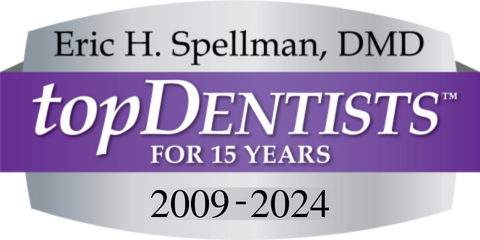What to Expect During a Same Day Crowns Procedure
 Dental crowns are one of the most common types of dental restorations, with countless patients receiving them every year. At Eric Spellman, DMD, we use revolutionary CEREC technology to restore and repair damaged teeth in a single day in Larchmont. CEREC same day crowns procedure in Larchmont can be used to address a variety of dental problems. These dental problems include:
Dental crowns are one of the most common types of dental restorations, with countless patients receiving them every year. At Eric Spellman, DMD, we use revolutionary CEREC technology to restore and repair damaged teeth in a single day in Larchmont. CEREC same day crowns procedure in Larchmont can be used to address a variety of dental problems. These dental problems include:
– Badly decayed, beyond what can be repaired with a cavity filling.
– Severely eroded, usually due to grinding or GERD
– Cracked or broken
– Undersized or misshapen
They are also used to support dental bridgework as they are attached to teeth either side of the gap.
Crowns look just like teeth but are hollow inside so that they can be placed over the top of your damaged or decayed tooth, encasing it completely inside. Once in place, it restores the strength, shape and function of your tooth, and thanks to dental crowns now being available in color-matched porcelain, they also look so natural that it will be virtually impossible to tell that it is no longer an original tooth.
The process to receive a dental crown in Larchmont usually involves a series of different appointments, including your initial consultation, an appointment to take moulds of your teeth, another to prepare your tooth, and finally one to fit your dental crown. When you have a supremely busy schedule already, the thought of trying to find time to attend all of these appointments can be frustrating, not to mention the fact that you will need to live with your decayed or damaged tooth until the crown is ready.
Fortunately, there is an alternative to undergoing a lengthy dental crown process. Dentistry has continued to evolve and thanks to the use of progressive CEREC technology, it is now possible to have a high-quality dental crown created the very same day.
What to expect during your CEREC Same Day Crown procedure
The process to receive a CEREC same day dental crowns is very straightforward. To help you feel prepared, here is what to expect when you arrive for your appointment.
Firstly, your dentist in Larchmont, Dr. Eric Spellman, will perform a dental exam of your teeth to ensure that a dental crowns is the best solution for your dental problem. If your dentist agrees that a crown is the most suitable treatment for your affected tooth, the tooth will then be prepped for receiving the new crown. This will involve removing any areas of decay that have accumulated or infected soft tissue.
Once your tooth has been prepped, your dentist will take a digital image of your tooth to be crowned. This is then sent to the CEREC machine for it to work its magic! The software will create a 3D model of your tooth which will be used to design your same-day crown.
After the design has been finalized, it is sent to a machine that will mill your crown while you wait. Since porcelain is available in a variety of shades, your dental team will choose one which most closely resembles your natural teeth, helping to make your new crown incredible discreet.
Once the crown is ready, our restorative and cosmetic dentist, Dr. Spellman, will check the fit against your tooth before cementing is permanently in place, polishing it and making sure it looks natural and attractive. If any revisions to the crown are required, they can be carried out before the permanent fitting takes place.
Benefits of Same Day Crowns Procedure
Unsurprisingly, same day dental crowns are becoming increasingly popular thanks to the array of benefits that they offer patients when compared to conventional crowns. These include:
- Fewer dental appointments.
- Less injections needed since everything is carried out on one day.
- Cutting-edge technology enables greater precision when creating your custom-fit crown.
- No need to wear an ugly metal temporary crown while you are waiting for your permanent replacement.
- Crowns that are just as durable as those used in conventional procedures.
- Improved function and appearance of your smile in just one day.
If you are interested in finding out more about same day dental crowns, our knowledgeable and professional dental team are on hand to answer your queries. Alternatively, why not contact us and arrange an appointment with our our dentist, Dr. Eric Spellman to discuss your individual circumstances and to find out if a dental crown is the best solution for your needs.
Contact Us For A Dental Crown Consultation
With over 30 years of experience and advanced training, Dr. Eric Spellman offers Larchmont patients advanced restorative and cosmetic dentistry treatments in Larchmont. In addition to traditional dental crowns, Dr. Spellman, offices the CEREC same day crowns procedure for patients looking for a quick, permanent solution to chipped, cracked, or broken teeth. Call our Larchmont, NY office today at 914-315-4446 to schedule a consultation. We also treat patients for CEREC Same Day Dental Crowns from Larchmont, Mamaroneck, Scarsdale, NY and many surrounding areas.
 Despite our best efforts to keep our teeth clean and free from problems, dental decay is a virtually inevitable occurrence. In most instances, a filling is sufficient to fill small to moderate-sized cavities caused by decay. However, if you have developed a large cavity in one of your molars or pre-molars, our dentist may recommend an inlay or onlay as the best course of treatment.
Despite our best efforts to keep our teeth clean and free from problems, dental decay is a virtually inevitable occurrence. In most instances, a filling is sufficient to fill small to moderate-sized cavities caused by decay. However, if you have developed a large cavity in one of your molars or pre-molars, our dentist may recommend an inlay or onlay as the best course of treatment.


 You only have to watch television or open a magazine to be inundated with images of models, celebrities and other notable figures with bright, white and attractive smiles. Society subconsciously tells us that the whiter our teeth are, the healthier and more appealing we will look, and the more successful we might be. Unfortunately, most of us have teeth that are naturally much more yellow in appearance. Learn how to whiten yellow teeth below and call our dentist office, Eric Spellman, DMD, for a
You only have to watch television or open a magazine to be inundated with images of models, celebrities and other notable figures with bright, white and attractive smiles. Society subconsciously tells us that the whiter our teeth are, the healthier and more appealing we will look, and the more successful we might be. Unfortunately, most of us have teeth that are naturally much more yellow in appearance. Learn how to whiten yellow teeth below and call our dentist office, Eric Spellman, DMD, for a  If you have lost a tooth previously and been living with a gap in your smile, you are probably becoming frustrated with the effects that it has and the way that it makes you feel about your teeth. If you don’t currently have a missing tooth, but are scheduled for a tooth extraction because you have a tooth that is beyond saving, you are undoubtedly already considering what your options are for replacing it. Dental implants are currently deemed to be the most successful and superior tooth loss solution currently available. There are many benefits of
If you have lost a tooth previously and been living with a gap in your smile, you are probably becoming frustrated with the effects that it has and the way that it makes you feel about your teeth. If you don’t currently have a missing tooth, but are scheduled for a tooth extraction because you have a tooth that is beyond saving, you are undoubtedly already considering what your options are for replacing it. Dental implants are currently deemed to be the most successful and superior tooth loss solution currently available. There are many benefits of  A smile is a simple gesture and something that comes naturally to us if we are happy or amused. Unfortunately, if you dislike the appearance of your teeth, smiling might be something that you try and avoid, perhaps by closing your mouth or covering it with your hand. You might also try to avoid drawing attention to your mouth in other situations, such as by not eating in public or engaging in close conversations. Our cosmetic dentist in Larchmont, Dr. Eric Spellman will give you the confidence to smile and will discuss what treatments are involved in a smile makeover once he examines your smile and creates a treatment plan.
A smile is a simple gesture and something that comes naturally to us if we are happy or amused. Unfortunately, if you dislike the appearance of your teeth, smiling might be something that you try and avoid, perhaps by closing your mouth or covering it with your hand. You might also try to avoid drawing attention to your mouth in other situations, such as by not eating in public or engaging in close conversations. Our cosmetic dentist in Larchmont, Dr. Eric Spellman will give you the confidence to smile and will discuss what treatments are involved in a smile makeover once he examines your smile and creates a treatment plan. Dental crowns are one of the most common types of dental restorations, with countless patients receiving them every year. At
Dental crowns are one of the most common types of dental restorations, with countless patients receiving them every year. At